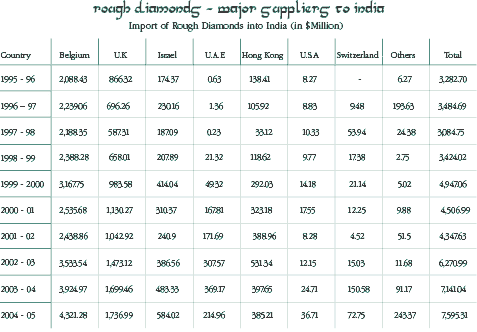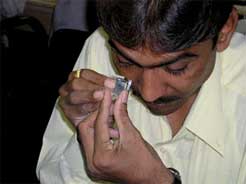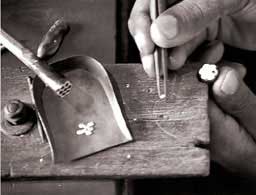The Legend from Rough to Polished
September 02, 06
|
|
It is the only diamond-cutting center that boasts the infrastructure to process more than double the annual rough mining output in the lower qualities of small goods every year. The figures are mind-boggling: out of an annual world-mined production of around 165 million carats, some 75 million carats of near-gem rough qualities are produced.
In 2005,
The Indian industry is production-driven. Available rough is processed, irrespective of market demand. One might argue that the sheer volume of manufacturing output has found the Indians unprepared on the marketing side. Presently, the country leads the cutting centers in terms of inventories and industry banking debt. In recent years, Indian-type polished stones set in diamond jewelry in the
Role of
In 1999, Argyle warned the Indian industry that its mining output would decline temporarily. Instead of reducing manufacturing capacity, Indian diamantaires competed for the less available rough. This is one of the main reasons for the price increases of the past few years. In 2000, Argyle’s rough diamond production was just 26.5 million carats, compared with a peak of 42.8 million carats in 1994. After a temporary production rise, Argyle is now expected to produce approximately 25 million carats up to 2018. It is currently moving from open pit mining to underground mining. As around 90 percent of Argyle’s output is processed in
However, Argyle sources stress that the importance should not be exaggerated. Argyle goods represent some 21 percent of the volume and only 8 percent of the value of
Argyle’s output is unique and the price range is wide (from goods at $1 per-carat to $1,500 per-carat). At an estimated average of $22 per carat, the mining output consists of 5 percent gem quality, 25 percent industrial goods and 70 percent near-gem. It is these near-gem qualities that go to
A decline in Argyle output of some 10 million carats easily translates to a reduction of polishing output of some 200 million stones!
The difficult nature of the rough requires special skills and equipment, which has tended to create a concentration of employment in one city, namely Ahmedabad (further details can be found on page 149). It has been argued that Argyle has a major influence on prices as there is limited international supply in these very small and cheap stones. This view may be exaggerated, as there is evidence that De Beers probably produces 40 percent of the world supply of these cheaper ranges, with Argyle contributing only 35 percent.
Indians realize that their rough suppliers have no alternative customers for the cheaper ranges of goods. The multi-channel supplies of near-gem rough have given the Indian industry considerable leverage over the DTC. Sightholders are demanding allocations of better quality goods as a ‘precondition’ to their willingness to take the cheap goods, or they can reject better goods when market conditions favor that course of action. Conversely, clients of the better qualities may not always be able to get the cheaper items from the DTC.
Rough Relations
In the late 1990s, De Beers failed in an attempt to acquire Ashton Mining Ltd, and thereby gain access to 40 percent of the Argyle rough. The failure to win the bid was mostly due to the Belgian Competition Authorities, which needed to give its fiat to the transaction. It somehow favored Rio Tinto. This failure was, by all accounts, a considerable set-back for the DTC.
The Supplier of Choice initiative of the DTC has, however, brought some disarray. Sightholders, who in the past depended solely on contractors, have recently been investing in their own manufacturing facilities, often taking labor away from the contractors just to put them on their own payroll. To quote one Sightholder, “everything that makes us look better in the eyes of the DTC is surely beneficial”. The fact, however, that some 70 percent of DTC boxes are traded makes one wonder how much Supplier of Choice has really impacted the local organization of the manufacturing structure.
As most of the DTC supplies to
The table below shows that, by value, some 56 percent of
 |
In addition, the DTC has an ‘indirect’ ownership in Hindustan Diamond Co. (HDC), which operates similarly to DTC subsidiary Diamdel in the other cutting centers. HDC has 200-300 clients, and does not provide credit. It sells mainly the cheaper ranges, or at least cheaper than the average Sight goods.
 |
As domestic mining output is minimal (but growing), the required raw materials for diamond manufacturing need to be imported. In the 2004-2005 fiscal year, the country imported $7.59 billion worth of rough diamonds (at an average value of $43.10 per carat), while polished exports totaled $11.18 billion (at $233.23 per carat). This shows an added value of 46.23 percent, contributing some $3.58 billion to the national economy. As inventory shifts as well as some creative accounting it creates statistical distortion in the analysis of a single year. It can be far more reliably shown that the average added value over a 15-year period totaled 35.7 percent (value addition measured as a percentage of rough imports). There is no other cutting center in the world that even comes close to this. 
REDISCOVERING ANCIENT DEPOSITS
The recent significant investments in Indian diamond exploration and mining deserve watching. From producing 17,400 carats in 1990, the current level is close to 100,000 carats per year. In the last 15 years, mining production has registered an annual growth of 10 percent. Within two to five years, production is expected to reach 3-4 million carats annually. De Beers’ Managing Director, Gareth Penny, lists
India 
Around 1959, exploration and mining for diamonds became a government monopoly, though not much was done. Only recently, after the government changed its mining statutes to allow foreign investment, has there been a renewed interest in diamond exploration. De Beers started to negotiate with various state and central government authorities well over a decade ago to secure exploration licenses. Actual exploration by De Beers commenced only in 2001. According to De Beers it is “actively exploring on granted reconnaissance permits in Karnataka, Andhra Pradesh, Chhattisgarh, Orissa, Madhya Pradesh, and Uttar Pradesh using conventional and proprietary technologies. Several applications are pending in other States. To date a total of 32 new kimberlite discoveries have been made.” 
Rio Tinto is also searching for diamonds in these regions.
